|
A GLOSSARY of MILLED BANDS
|
|
| How to Post Photos |
REGISTER (click here)
|
|
A GLOSSARY of MILLED BANDS
|
|
| How to Post Photos |
REGISTER (click here)
|

|
 SMP Silver Salon Forums SMP Silver Salon Forums
  American Silver before sterling American Silver before sterling
  Cream jug Cream jug
|
| next newest topic | next oldest topic |
| Author | Topic: Cream jug |
|
ahwt Posts: 2334 |
  
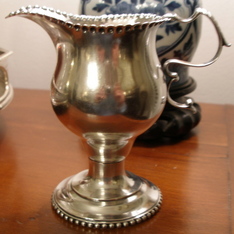 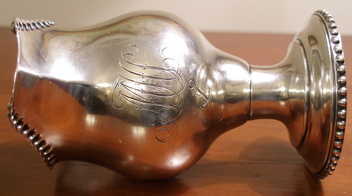 This is a little cream jug with punch beading on the rim and a beaded edge on a circular foot. The jug has several features that were interesting to me. First, the engraving is interesting as underneath the letters is an anchor. I think the initials are MHS and whoever that was must have had an interest in ships or shipping. Sorry about have the jug on its side for this picture as I could not get light to the engraving otherwise. Secondly, the picture below shows the underneath part of the base where some of the silver has worn away. You can see how the beaded portion was attached with, I assume silver solder every quarter inch or so. I have always assumed that there would be a continuous joint rather than the spot type. Was this done to save silver, time or for some other reason? The picture below shows the handle and the top portion has geometric pattern rather than what I would assume would normally be a leaf pattern. The last two pictures show the same marks from different angles. The letters are I.T and since none of my references show any American silversmith as a good possibility, I thought I would post it in the British/Irish section. Also, the use of three marks in a circle is attractive, but I think somewhat unusual for American silver. Finally, the underneath portion of the base still has the hammer marks showing. I have always assumed that was an American characteristic rather than a British or Irish one. On free blown glass the British and Irish usually polished the pontil, while on American glass it is often left rough and I thought the same care to the base of silver would be done. IP: Logged |
|
nihontochicken Posts: 289 |
  
The mark is interesting and unique in that it appears to me to be "I(period)T(no period)". Though Ensko IV shows a number of different "IT"s, there is only one with the single period after the "I" and set in a plain rectangular border. It is for Jonathan Trott, Jr., New London, Conn., 1795. Looks to be about the right period. IP: Logged |
|
ahwt Posts: 2334 |
  
I did see that one, but I think his may be a pellet instead of a period. Also I think his mark fills up the space more the this IT. John Targee had an IT mark with a period after the I. But I think he also had a period after the T and he may be a bit late for this style. IP: Logged |
|
swarter Moderator Posts: 2920 |
  
This could well be Joseph Toy of Abington, MD, w. 1776 - 1795. He seems to have characteristically stamped his hollow ware three times is this pattern. His mark had periods after both letters, and I think I see the second one as well in some of the pictures, although it is not as distinct. The mark is also described as having a distinctive flaw "a thin wavy line running from the left drop of the cross of the T down towards the foot of the I". Depending on the lighting, some of the punches in the photographs show a line in that position, more straight than wavy, but then the die may only have started to crack when it was used on this piece. Examine the marks carefully under magnification, and look for these two features. If they are there it is his mark, and it is a nice find. IP: Logged |
|
nihontochicken Posts: 289 |
  
The Trott, Jr. mark in my book definitely contains a period instead of a pellet. However, the mark in the book does not show slightly rounded corners as do your three marks. The only other candidate I find is a questionable attribution to a John Tweedie in Dublin in the late eighteenth century, but that mark definitely contains a pellet, not a period. Otherwise, one might make a case that the piece is a duty dodger, but that's a stretch. The Trott attribution seems firmer to me, FWIW. Good luck! IP: Logged |
|
ahwt Posts: 2334 |
  
I looked in the Eighteen and Nineteen Maryland Silver book by Goldsborough and the wavy line seems to be there as pictured on page 46. It starts the same place on the T and ends the same place on the I and is wavy. Only one of the marks on the cream jug has what might be a period at the end of the T, but I guess only one would be needed. Goldsborough also notes that Toy struck his mark three times on the bottom of a pictured cann so that method of marking also fits Toy habits. She provides a ca.1780 for the picture cann so the break in the die must have occurred shortly after Toy started working. Thanks to both of you for all the information. [This message has been edited by ahwt (edited 03-25-2005).] IP: Logged |
|
wev Moderator Posts: 4121 |
  
Which book is that? The only initial mark I have ever seen given to John Trott is J•T; there are some badly drawn versions that have been published, but they are not given credence now. I would agree with Swarter that Toy is a good candidate for the maker. IP: Logged |
|
ahwt Posts: 2334 |
  
Ensko III on page 199 shows Jonathan Trott, Jr. as I.T – however Belden showed the period as a pellet so I discounted Ensko. Also the letters are too close to the edge on the Trott mark. IP: Logged |
|
swarter Moderator Posts: 2920 |
  
On closer examination, I can make out the second period in all three strikes on the lower picture - it shows best in the one on the upper left, but can be seen in the other two less distinctly. On comparison with the photo of the recognized mark in Maryland Silver, the wavy defect is in exactly the same place as it can be seen as bent in the right punch and straight in the bottom punch in your lower photo. Wavy, bent, straight, it is all the same, depending on the direction of the light. It could be a scratch as well as a break (an engraver's "oops"?), but it is without a doubt the same punch even if the second (weaker) period is not visible. Congratulations! [This message has been edited by swarter (edited 03-26-2005).] IP: Logged |
|
agleopar Posts: 850 |
  
ahwt you were wondering about the solder being applied in small bits every quarter inch? It is one way of soldering not so much to save silver, but more to control it when soldering. The solder is cut into roughly 1/8 in pieces called pailons (sp?) and placed with wet flux on top of the join of the beaded wire and the creamer (it is upside down). It is then heated to temperature and the solder flows, hopefully into the join. In the spot with no solder it has not worn away but never got in there, the pailon in that spot fell off or it got too hot and the solder flowed nearby and was later filed off. A faster more modern way to solder, which may have been done in the 1700's, is to stick feed the solder. A 2 ft thin stick of solder is hand held and when the piece is at soldering temp. it is fed into the join in one spot and if the heat is correct the solder will flow all the way around. This takes practice and would not be done by a beginner. Hope this is helpful. IP: Logged |
|
swarter Moderator Posts: 2920 |
  
quote: This style of cream pot, which replaced the three-legged variety, was at the height of its popularity in the 1770's, and was on its way out in the 8O's, so this may have been one of Toy's earlier pieces. By the 90's the popular style was the Neoclassical urn shape. see this thread (Early cream pot -- provenance lost) for an example of the earliest style. IP: Logged |
|
ahwt Posts: 2334 |
  
agleopar, Thank you for the information. The whole process of making silver objects is intriguing, particularly the joining of parts together. When the reason for doing something is explained I think one can get a better appreciation for the skill in making objects. Swarter, Thanks for the link to that thread as I had forgotten it. I also found my copy of Pleasants and Hill book on Maryland silversmiths and enjoyed reading about Joseph Toy's life. There actually is quite a bit of silver identified being made by Joseph Toy and it may be possible to find out who MHS was. It would also seem that Toy was known to be an excellent engraver as is clear from this pot. Art Art IP: Logged |
|
akgdc Posts: 289 |
  
Fabulous piece! Could you post a clearer photo of the monogram? IP: Logged |
|
ahwt Posts: 2334 |
  
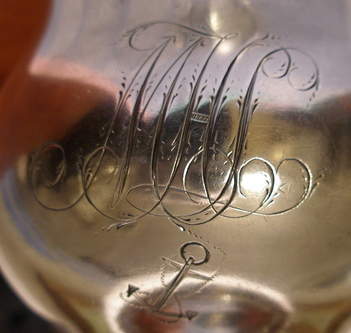 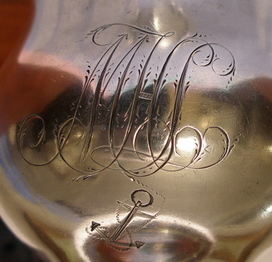 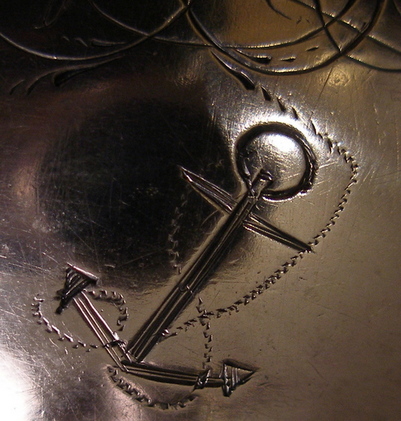 Hope these pictures are a little better. The anchor seems to have a chain that materializes from the right leg of the M. The anchor chain, I think, was fashioned with a different tool than the other portions of the monogram. The first two letters are MH and I believe that the last letter is S. IP: Logged |
|
swarter Moderator Posts: 2920 |
  
I forst thought it was MHS too, but in the enlarged picture I believe the initials are MHL, as the lower loop of the last letter seems to loop back across to the right. [This message has been edited by swarter (edited 03-27-2005).] IP: Logged |
|
ahwt Posts: 2334 |
  
Thanks Swarter for noticing that. I believe I have made that mistake before. Art IP: Logged |
|
akgdc Posts: 289 |
  
Yes, and it does look contemporary with the pot itself. You should run this by the Baltimore Museum of Art and the Maryland Historical Society. IP: Logged |
|
Ulysses Dietz Moderator Posts: 1265 |
  
I'd also toss in here that, if this was a wedding gift (the monogram could in fact be the monogram of TWO people), the anchor could simply be a device denoting a wish for good luck. Faith Hope and Charity were commonly depicted as a cross, an anchor, and a heart. I remember being confused by the nautical theme before realizing that there is the spiritual meaning. But, it could be a ship's owner, too. In any case, it's a neat, unusual bit of engraving. IP: Logged |
|
salmoned Posts: 336 |
  
I may be a bit finicky, but doesn't the quality of the anchor engraving seem rather bad compared to the monogram? I would have expected something better thought out and rendered. IP: Logged |
|
swarter Moderator Posts: 2920 |
  
I doubt the anchor is contemporary with the monogram. I believe it was added later, as its placement results in an unbalanced engraving. IP: Logged |
|
Patrick Vyvyan Posts: 640 |
  
From the angle of the photo, it is dificult to see - but could the cross bar of the central H be an addition? If so the monogram could read MJCL. IP: Logged |
|
ahwt Posts: 2334 |
  
I received very nice letters from both the Baltimore Museum of Art and the Maryland Historical Society. The latter has a curator for their maritime collection and she was kind enough to look through her records for any shipping captains where L or H was the first letter of the last name. Nothing turned up by this search. However, Ulysses and Patrick may be on the right track. The anchor may have nothing to do with ships, but instead have some meaning about the joining of two people. The cross bar could be the symbol for tying MJ and CL together and the anchor could have something to do with steadfastness. The engraving, as a whole, seems to have the same amount of wear and that would leave me to believe the engraving was all accomplished at the same time. The anchor is similar to that used by several English ceramic factories of this time period, and may have symbolized the same idea as they intended. IP: Logged |
|
ahwt Posts: 2334 |
  
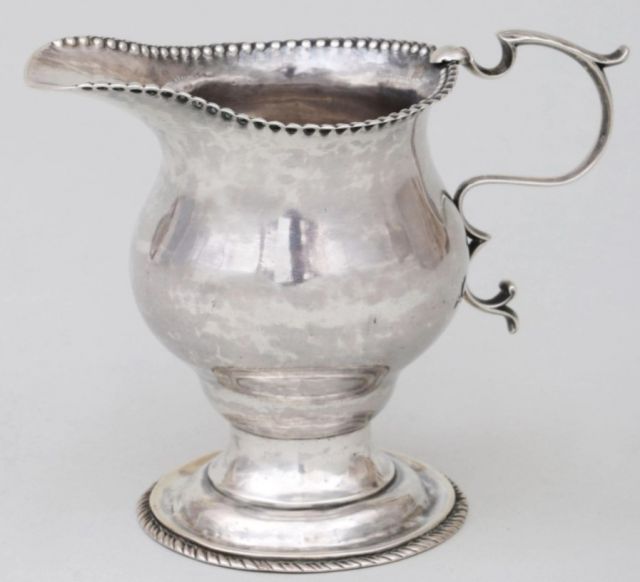 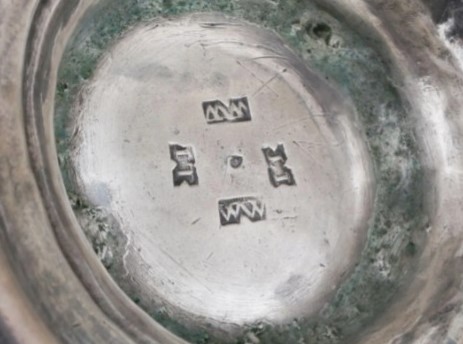 The above cream pot by Joseph Toy and William Wilson recently came up at an auction held by South Bay auctions. I thought it was interesting in that the pot is almost identical to the one I posted some time ago. Based on the style the auctioneers believe it was circa 1785. Pheasants and Sill in their book on Maryland Silversmiths indicate that are some spoons existing that bear the Toy Wilson mark that are also circa 1785. IP: Logged |
All times are ET | next newest topic | next oldest topic |
  |
|
Ultimate Bulletin Board 5.46a
|
1. Public Silver Forums (open Free membership) - anyone with a valid e-mail address may register. Once you have received your Silver Salon Forum password, and then if you abide by the Silver Salon Forum Guidelines, you may start a thread or post a reply in the New Members' Forum. New Members who show a continued willingness to participate, to completely read and abide by the Guidelines will be allowed to post to the Member Public Forums. 2. Private Silver Salon Forums (invitational or $ donation membership) - The Private Silver Salon Forums require registration and special authorization to view, search, start a thread or to post a reply. Special authorization can be obtained in one of several ways: by Invitation; Annual $ Donation; or via Special Limited Membership. For more details click here (under development). 3. Administrative/Special Private Forums (special membership required) - These forums are reserved for special subjects or administrative discussion. These forums are not open to the public and require special authorization to view or post. |
|
copyright © 1993 - 2022
SM Publications
All Rights Reserved. Legal & Privacy Notices |